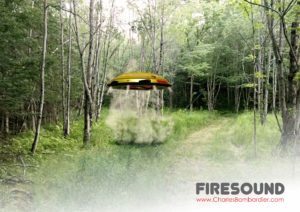
Designed by Imaginactive founder Charles Bombardier, Firesound is a flying-saucer shaped, firefighting drone design powered by hydrogen fuel cells and lifted by four electric turbofans – kind of like a standard quadcopter topped with a dome.
The drone has already been crafted as a prototype – the conceptual aspect lies in how Firesound would extinguish small fires – through sound waves.
Bombardier hopes to mate UAV technology with a breakthrough fire extinguisher – first reported in Physics World – that can use sound waves to separate burning material from oxygen, snuffing out small fires – like unattended campfires in parks.
Researchers discovered bass frequencies between 30 and 60 Hz produce the best extinguishing power (which means the Seinfeld theme should be able to take out an entire forest fire).
“Of course the technology needed to extinguish small fires with sound is just getting started, but it will evolve, and so will drone technology,” Bombardier said.
And Bombardier is well positioned to quickly adopt new inventions as they emerge. His non-profit Imaginactive serves as an online clearinghouse for new tech ideas.
“We share our ideas openly online so they can grow, evolve and inspire people,” Bombardier said. “We always seek out new innovative ideas and we encourage young creative entrepreneurs to contact us.”
Advances in UAV technology are reaping major benefits for firefighting agencies around the world. The Korea Advanced Institute of Science and Technology recently unveiled Fireproof Aerial Robot System (FAROS) to the firefighting world.
The drone system can not only detect fires in the tallest of skyscrapers, it can also search an engulfed building and transfer real-time data to human firefighters to build a better game plan for extinguishing a blaze. The sensor drones can also withstand blazes in excess of 1,832 degrees Fahrenheit.
In October, Massachusetts-based Olin College announced a partnership with MIT and drone company Scientific Systems to develop a vanguard of self-flying UAVS that can gather airborne, real-time data to send to crews fighting dangerous wildfires. Logistical data can help experts pinpoint how the fire is likely to spread and how best to deploy on-the-ground crews.
Jason is a longstanding contributor to DroneLife with an avid interest in all things tech. He focuses on anti-drone technologies and the public safety sector; police, fire, and search and rescue.
Beginning his career as a journalist in 1996, Jason has since written and edited thousands of engaging news articles, blog posts, press releases and online content.
Email Jason
TWITTER:@JasonPReagan
Subscribe to DroneLife here.